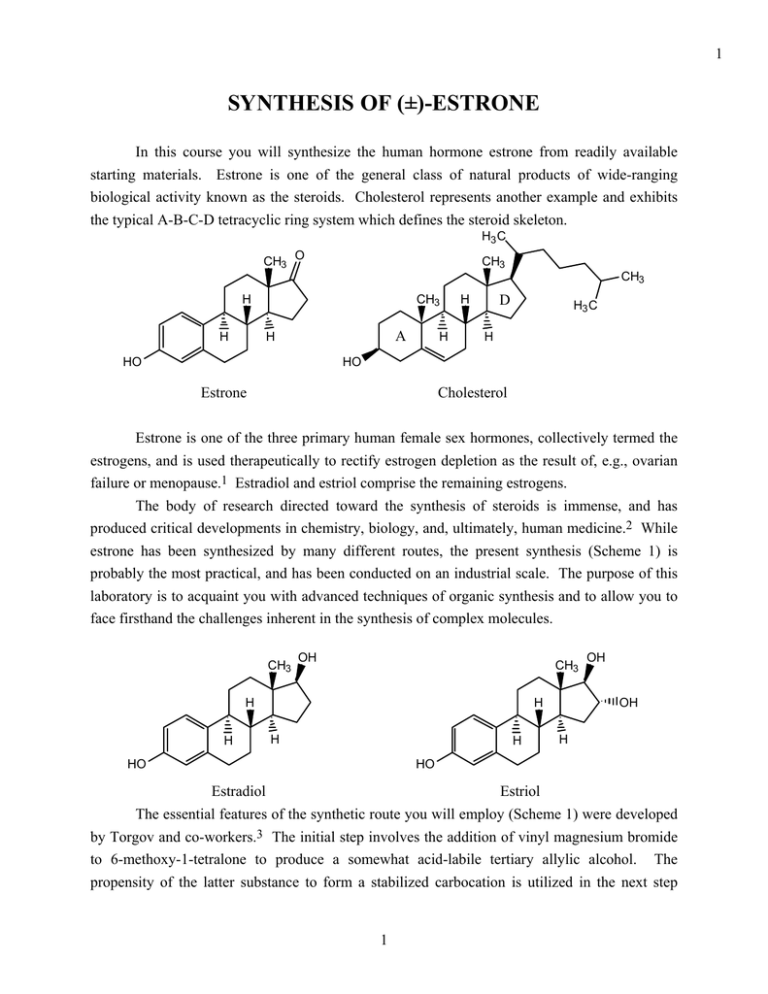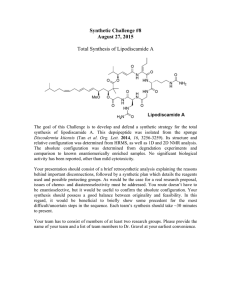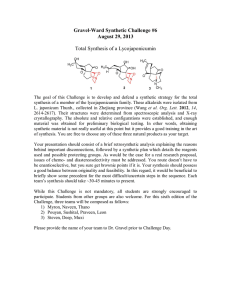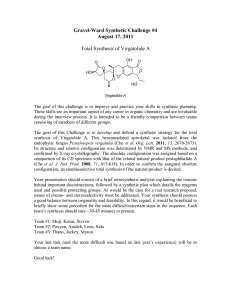manual pad - Chemistry at Caltech
advertisement

1 SYNTHESIS OF (±)-ESTRONE In this course you will synthesize the human hormone estrone from readily available starting materials. Estrone is one of the general class of natural products of wide-ranging biological activity known as the steroids. Cholesterol represents another example and exhibits the typical A-B-C-D tetracyclic ring system which defines the steroid skeleton. H3 C CH3 O CH3 CH3 H H A H HO H CH3 D H H3 C H HO Estrone Cholesterol Estrone is one of the three primary human female sex hormones, collectively termed the estrogens, and is used therapeutically to rectify estrogen depletion as the result of, e.g., ovarian failure or menopause.1 Estradiol and estriol comprise the remaining estrogens. The body of research directed toward the synthesis of steroids is immense, and has produced critical developments in chemistry, biology, and, ultimately, human medicine.2 While estrone has been synthesized by many different routes, the present synthesis (Scheme 1) is probably the most practical, and has been conducted on an industrial scale. The purpose of this laboratory is to acquaint you with advanced techniques of organic synthesis and to allow you to face firsthand the challenges inherent in the synthesis of complex molecules. CH3 OH CH3 H H H H H OH OH H HO HO Estradiol Estriol The essential features of the synthetic route you will employ (Scheme 1) were developed by Torgov and co-workers.3 The initial step involves the addition of vinyl magnesium bromide to 6-methoxy-1-tetralone to produce a somewhat acid-labile tertiary allylic alcohol. The propensity of the latter substance to form a stabilized carbocation is utilized in the next step 1 2 wherein the cation is trapped with the enol form of 2-methyl-1,3-cyclopentanedione. Subsequent olefin isomerization and ring closure-dehydration, again involving cationic intermediates, produces the complete tetracyclic steroid skeleton. This is a very powerful synthetic operation and illustrates the value of convergency in synthesis.4 It should be noted that this tetracyclic intermediate, 3-methoxy-1,3,5(10),8(9),14(15)-estrapentaene-17-one, is chiral and has been produced in racemic form. Your synthesis of estrone, therefore, will also produce racemic material, unlike estrone derived from natural sources. The next four steps involve two different types of reduction reactions that lead stereoselectively to hydrogenation of the non-aromatic double bonds. Also included among these reactions is a protection-deprotection sequence that preserves the D-ring carbonyl through the reduction with lithium and liquid ammonia. It is rare for a multi-step synthetic sequence not to include at least one protection step.4,5 In the final step of the synthetic route, estrone methyl ether is subjected to hot pyridinium chloride to remove the aromatic methyl ether, which might also be regarded as a protective group. This series of steps comprising the synthetic route to estrone represents a collection of some of the most basic, and important, operations in the repertoire of the synthetic chemist. By successfully completing this synthesis of estrone, you will learn many aspects of synthesis, such as the prudent rationing of chemical intermediates, that will serve you well in future research endeavors in chemistry. References 1. Barnhart, E. R. (pub.) Physicians' Desk Reference, 42nd ed.; Medical Economics Company:, Oradell, 1988 pp 544-547 and references therein. 2. Blickenstaff, R. T.; Ghosh, A. C.; Wolf, G. C. Total Synthesis of Steroids; Academic Press: New York, 1974. 3. (a) Ananchenko, S. N.; Torgov, I. V. Tetrahedron 1963, 18, 1335. (b) Yates, P.; Douglas, S. P.; Datta, S. K.; Sawyer, J. F. Can. J. Chem. 1988, 66, 2268. 4. Corey, E. J.; Cheng, X.-M. The Logic of Chemical Synthesis; Wiley: New York, 1989. 5. Greene, T. W.; Wuts, P. G. M. Protective Groups In Organic Synthesis; Wiley: New York, 1991. 2 3 Scheme 1 3



